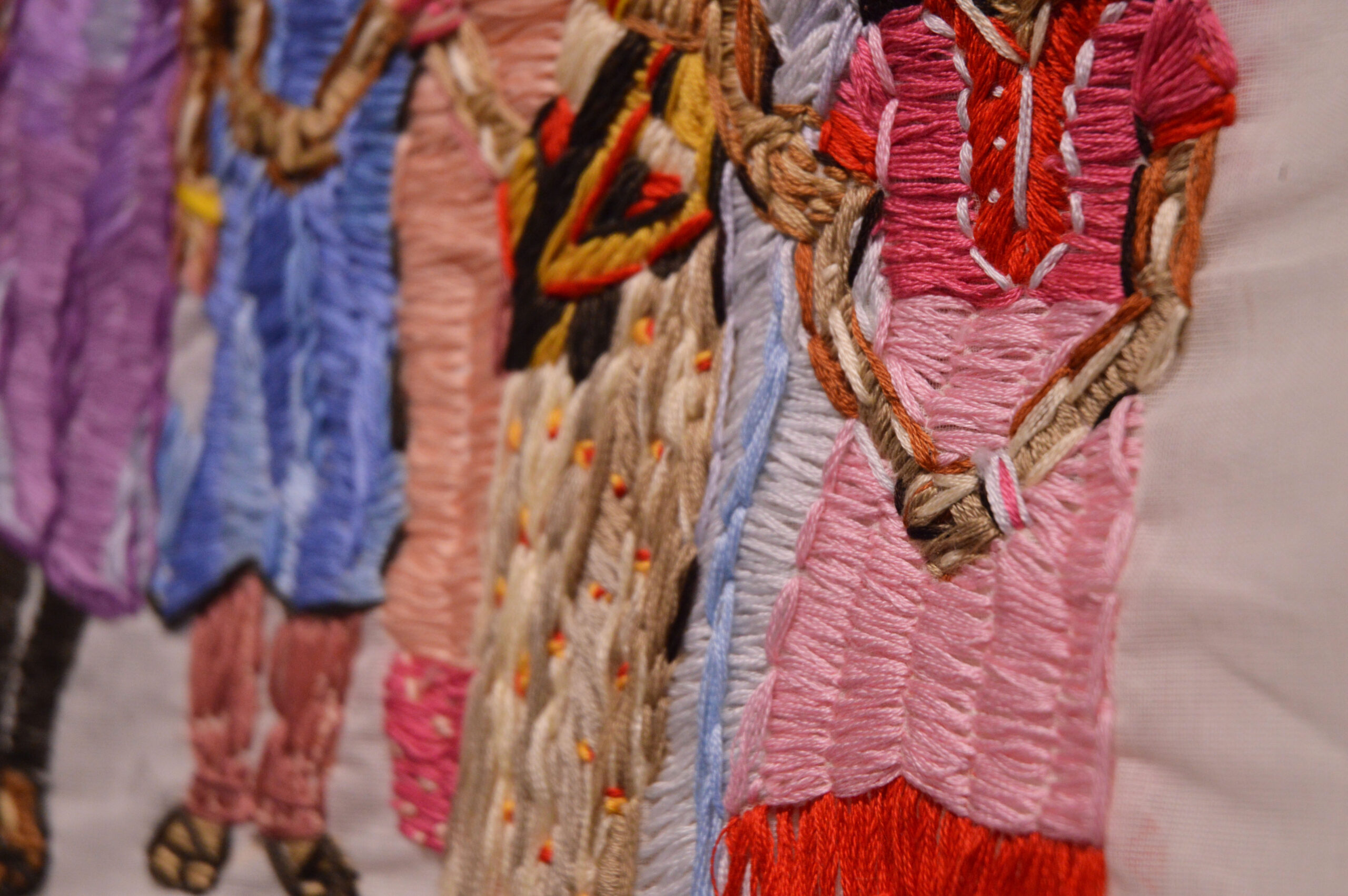Mother Love: Par Nair’s the stories we don’t tell
Reviewed by Maggie Burton
Showing at Eastern Edge in the Main Gallery until March 16, 2024
Based in the Greater Toronto Area, Par Nair works across several different disciplines including embroidery, oil painting, and poetry. She presents her vision for the stories we don’t tell on a large scale that is befitting of the magnitude of her subject: the mother. This is the artist’s first solo exhibition in Newfoundland and Labrador, and the first Main Gallery installation of 2024 for Eastern Edge.
As a poet and a mom of four young children, I am grateful to artists who explore the often invisible work of mothering, a topic that for many reasons can be difficult for an artist to approach or for a viewer to encounter. Nair’s homage to her ancestors is one of generous, abundant love and admiration and invokes a nostalgia for the home that mothers represent through a lens of diasporic longing.
As the viewer enters the gallery space, the words the stories we don’t tell cling to the wall beside two embroidered family portraits. A portrait of a woman’s face introduces the exhibition through a palette of warm browns veiled in red, black and gold. Using traditionally feminine craft such as hand-stitched embroidery on fabric, the labour that is often performed by women to preserve tradition is explored, and further, the artist is directly involved in the work of cultural safekeeping.
The first installation begins with the passport photo of the artist’s mother, placed on a ledge next to a string of artificial marigolds, which bring brightness and positive energy to the space. My own mother taught me to make dandelion chains and hang them around my head like a crown. Through this simple act of connection, she taught me to make magic out of my own two hands. As I walked through the exhibition, there were several instances where I smiled and remembered the experiences I had making things with women of my own family. My own grandmother was a seamstress and I often sat with her while she manipulated large swaths of fabric through her sewing machine. My mother is an oil painter and she enshrined my face and my brother’s as toddlers on canvas. The artist succeeds, in my opinion, in speaking across communities and across time to remind the viewer of the importance of a woman’s hand as a tool to create beauty, to make something out of nothing.

Exhibition detail from the stories we don’t tell by Par Nair, photo by Laura Sbrizzi
Nair then reflects on her mother’s passport photo through a dozen interpretations of her face in oil paint on small wooden squares reminiscent of a wall of school photos that hang in many a family’s home. In this case, however, it’s the daughter who has put in the work to hang up pictures of her mother’s face. Next are two larger paintings of a young woman. In each, the woman’s face holds space for limitless hope and love, and a longing that defies a linear theory of time.
Next, a series of four vibrant sarees, functioning as long embroidered letters, drape from the ceiling to the middle of the floor. Each begins “dear amma” or “mother”. Through Nair’s use of straightforward, declarative language she attempts to hold an all-consuming parent-child love in stanzas such as “mother, how i long/to love you/the way you have/loved me” and “dear amma, what is home/if not you?”
The subsequent wall hosts a series of four family portraits on sheer white, gold-bordered fabric called kasavu mundu, a traditional menswear fabric from the Indian state of Kerala. In the final image, there is an invisible person represented by a phone, who is still being held in the mother’s hands. Here, she is both alone, and not alone, as is often the case for mothers.
Following this series are two final poems stitched onto a cotton textile called thortu, which is used both in the private space as a bath towel and in the public sphere as an object of ritual or adornment. These poems contemplate the endurance of mother love, “a love that baffles chaos/a love that stops time”. Nair posits “mother, what is ritual if not you/ritual is magic, as are you.”
As a white woman from Newfoundland, I come from a culture where women have traditionally held both family and communities together through the hard work of caregiving. Often, what is left over after doing this work is a love that is difficult to access. Par Nair’s work reminds us that mother love can be big, bottomless, and if you look closely, it is often right there on the surface.
Maggie Burton lives in St. John’s with her four children where she works as a City Councillor, musician, and writer. Her first book of poetry, Chores, was published by Breakwater Books in 2023.
